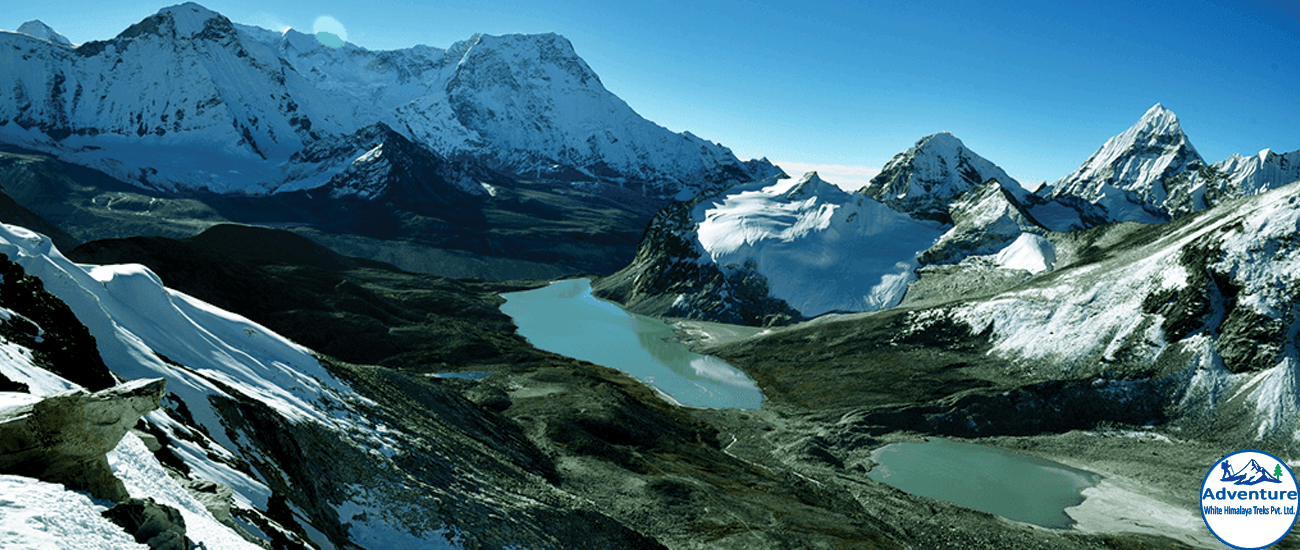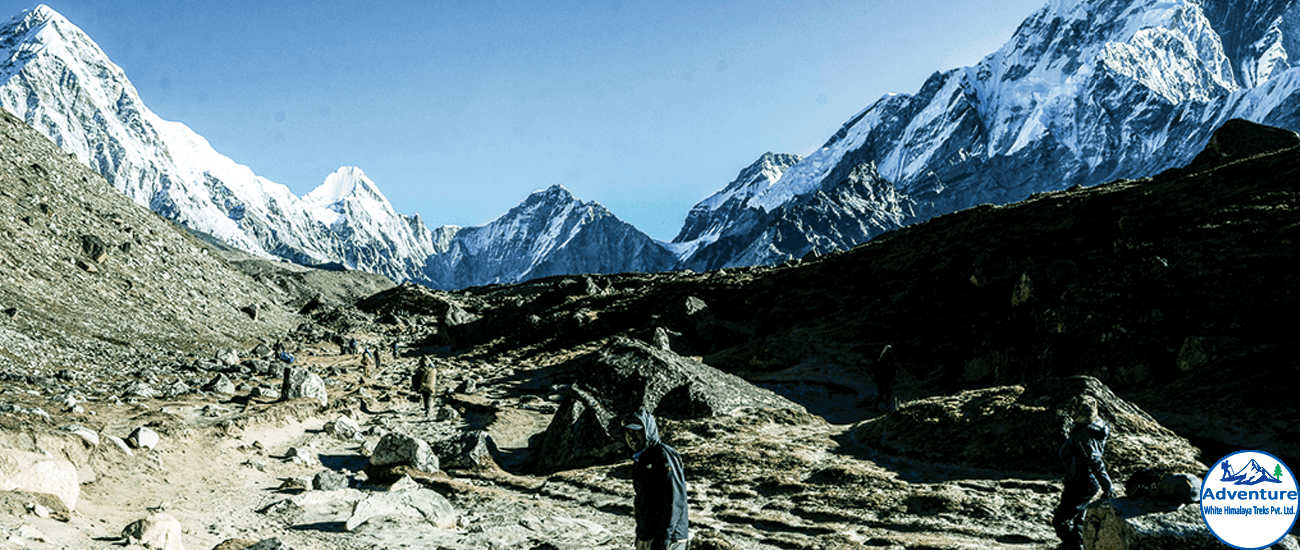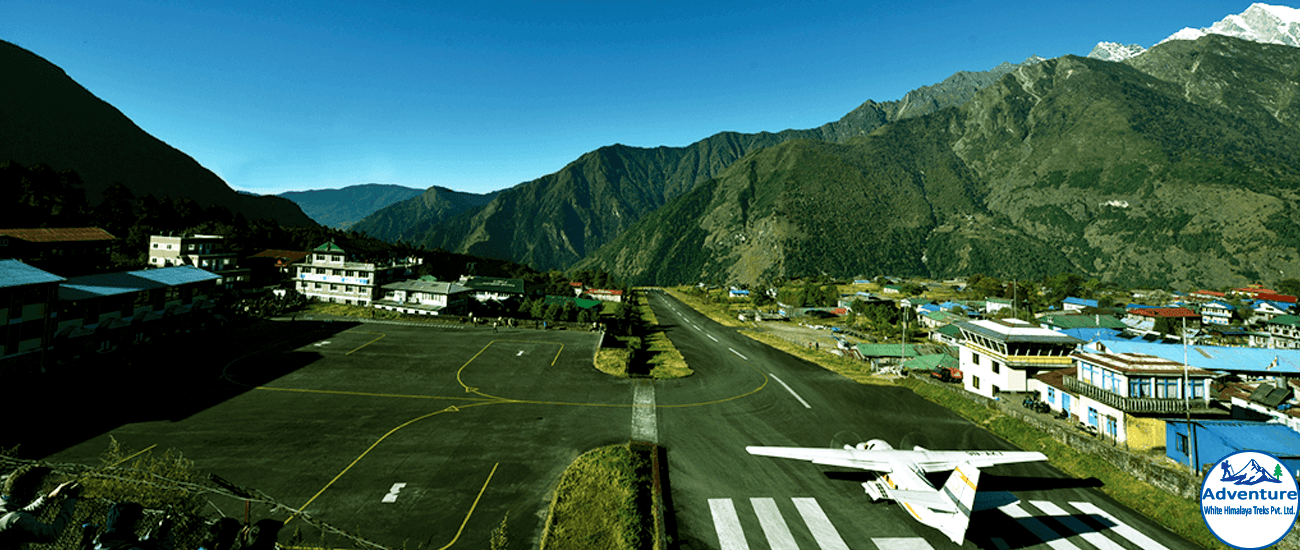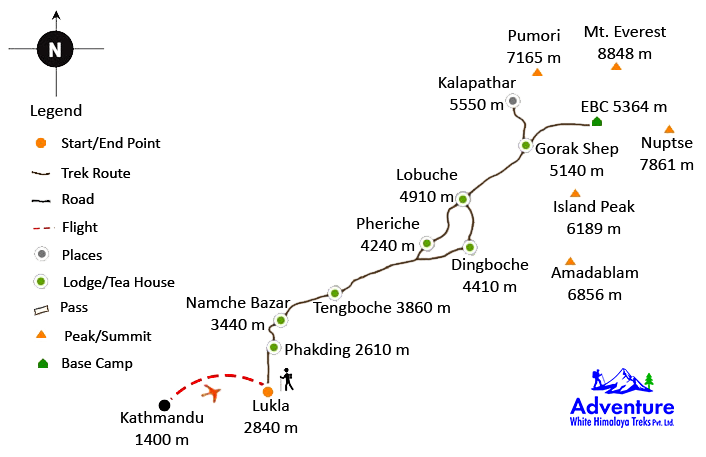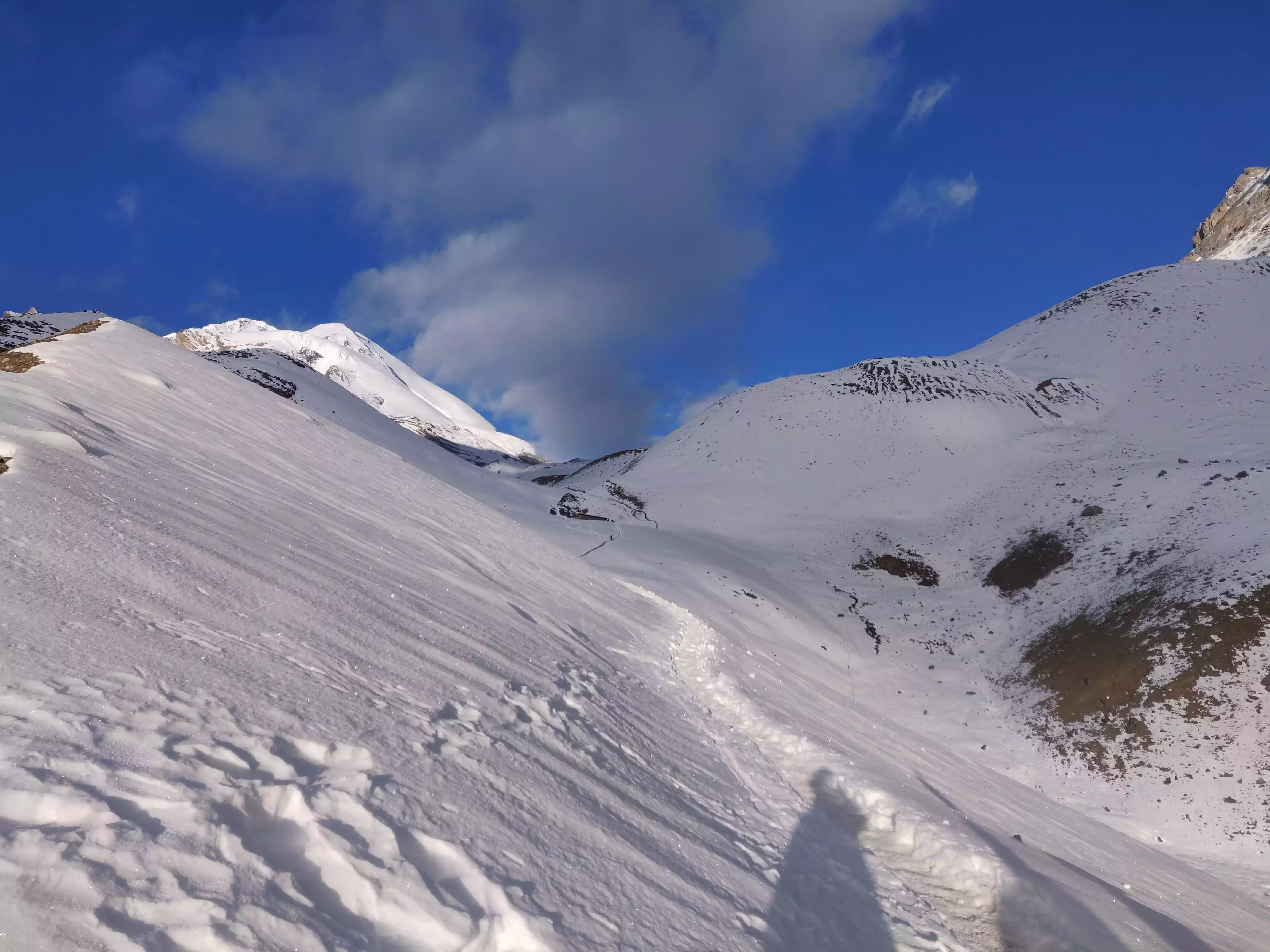The cost of the Everest Base Camp trek can vary significantly depending on several factors, including the trekking season, the duration of your trek, the level of service you choose, and whether you join a guided tour or go independently. Here’s a general breakdown of trek costs:
- Guided Trek: If you choose to go on a guided trek, which is recommended for safety and convenience, the cost typically includes permits, accommodation, meals, transportation to Lukla, a guide, and sometimes a porter. On average, guided treks can range from $1,200 to $2,500 per person.
- Independent Trek: Going independently will generally be more budget-friendly, but you’ll need to arrange your permits, accommodation, meals, and transportation on your own. Budget travelers can complete the trek for around $800 to $1,200, excluding gear and permits.
- Peak Season vs. Off-Peak Season: Trekking during the peak seasons (spring and autumn) tends to be more expensive due to higher demand. Off-peak seasons (winter and monsoon) offer lower prices but come with more challenging weather conditions.
- Duration: The longer you stay on the trek, the higher your overall costs will be. The standard Everest Base Camp trek takes around 12-14 days, but you may choose to extend it by adding side treks or additional acclimatization days.
- Quality of Accommodation: Luxury lodges with better amenities are available along the route but come at a higher cost. Basic teahouses provide a more budget-friendly option.
- Additional Expenses: Budget for optional activities, unforeseen expenses, and souvenirs.
- Trekking Gear: If you need to purchase or rent trekking gear in Kathmandu, budget accordingly. This cost can vary depending on your equipment needs.
Cancellation Fees
Before embarking on the Everest Base Camp trek, it’s essential to be aware of the potential cancellation fees in case your plans change. These fees can vary depending on the tour operator, so it’s crucial to read and understand their cancellation policy before booking. Typically, the closer you cancel to your departure date, the higher the cancellation fees may be. Consider purchasing travel insurance that covers trip cancellations to mitigate potential losses.
Optional Activities
While the Everest Base Camp trek offers incredible natural beauty and cultural experiences, there are optional activities you can choose to enhance your adventure:
- Helicopter Tour: If you want a different perspective of Everest, consider a helicopter tour to get a bird’s-eye view of the region.
- Side Treks: There are side treks to Gokyo Lakes, Chhukhung Valley, and other nearby destinations. These can add extra days and costs to your trek but offer unique experiences.
- Cultural Tours: In Kathmandu, you can explore historical sites like Durbar Square and visit ancient monasteries.
Budget on Site
Here’s a breakdown of typical on-site expenses for the Everest Base Camp trek:
- Permits: You’ll need permits for the trek, including the Sagarmatha National Park Permit and the TIMS (Trekkers’ Information Management System) card. These typically cost around $50 to $60 in total.
- Accommodation: Depending on your choice of lodges or teahouses, budget around $20 to $50 per night for accommodation, including meals.
- Meals: Meals in teahouses or lodges can vary in price. Budget approximately $20 to $30 per day for three meals, including snacks and hot drinks.
- Water: While tap water is not safe to drink, bottled water is available but can be expensive. Consider using water purification tablets or a water filtration system to reduce costs.
- Trekking Gear: If you need to rent or purchase trekking gear in Kathmandu, budget accordingly. Prices can vary based on the quality and type of equipment.
- Tips: It is customary to tip your guides and porters at the end of the trek. A recommended guideline is around 10% of the total trek cost, which can be divided among the team.
- Miscellaneous: Budget for unforeseen expenses, such as extra snacks, Wi-Fi charges, and hot showers, which can add up over the course of the trek.
Tips for Everest Base Camp Trek
- Pack Light: Packing efficiently can save you money on porter fees. Carry only essential items and clothing.
- Local Currency: It’s advisable to carry Nepalese Rupees in small denominations for small purchases along the trail. Larger towns like Namche Bazaar have ATMs.
- Negotiate Prices: In some cases, you may be able to negotiate prices for accommodation or goods, especially in off-peak seasons.
- Travel in the Off-Peak Season: Consider trekking during the shoulder seasons (spring and autumn) to take advantage of lower prices and fewer crowds.
- Travel Insurance: While it’s an upfront cost, travel insurance can save you money in case of emergencies or trip cancellations.
- Share Costs: If you’re traveling with a group, consider sharing the cost of accommodation, meals, and guides to reduce individual expenses.
Tipping for Guides and Porters:
- Guide: It is customary to tip your guide at the end of the trek. A common guideline is to tip around 10% of the total cost of the trek. For a 12- to 14-day Everest Base Camp trek, this might translate to approximately $100 to $150 per person for your guide.
- Porters: If you hire a porter to carry your main backpack, you can tip them separately. A typical tip for a porter is around $5 to $10 per day per porter, depending on the weight they carry and the distance covered.
- Group Tip: In some cases, especially if you are part of a group, it’s customary to pool money from all group members and distribute it among the guide and porters. Your guide can help you organize this.
Tipping at Local Restaurants:
- Restaurants: When dining at local restaurants (teahouses or lodges) along the trek, it is not mandatory to leave a tip, but it is appreciated. You can round up the bill to the nearest reasonable amount or add a small amount as a token of appreciation for good service.
- Porters and Staff: If you have good interactions with the staff at the lodges or teahouses where you eat, you can consider leaving a small tip in the communal tip box, which is often available for distribution among the staff.
- Politeness: While tipping is a way to show gratitude, always remember to be polite and courteous to the staff, even if you choose not to tip or tip minimally.
Tipping is a way to acknowledge the hard work and dedication of your guides, porters, and the hospitality staff along the trail. Keep in mind that these are general guidelines, and the actual amount you tip may vary based on the level of service you receive and your personal satisfaction.
The Everest Base Camp trek is an exhilarating adventure that takes you through diverse terrains and changing weather conditions. Proper equipment is crucial to ensure your safety, comfort, and enjoyment during the trek. Here’s a comprehensive list of the equipment you’ll need:
Small Personal Equipment:
- Backpack: A comfortable and well-fitted backpack (30-40 liters) to carry your daily essentials, such as water, snacks, extra clothing, and personal items.
- Trekking Boots: Sturdy, waterproof, and comfortable trekking boots with good ankle support.
- Hiking Socks: Moisture-wicking and warm socks to prevent blisters and keep your feet dry.
- Trekking Poles: Collapsible trekking poles for stability and balance, especially during descents.
- Headlamp: A headlamp with extra batteries for nighttime use and in lodges with limited lighting.
- Sunglasses: UV-protective sunglasses with side shields to shield your eyes from the strong mountain sun.
- Water Bottles: Two durable water bottles or a hydration reservoir to stay hydrated. Consider insulated ones to prevent freezing in cold temperatures.
- Duct Tape and Repair Kit: For quick fixes on gear and clothing.
- Knife or Multi-tool: A versatile tool for various purposes.
- Whistle: For safety and signaling in case of emergencies.
Personal Pharmacy:
- Prescription Medications: Any prescription medications you need, along with a copy of the prescription.
- Pain Relievers: Over-the-counter pain relievers like ibuprofen or acetaminophen.
- Diamox: A medication that can help prevent altitude sickness. Consult a doctor before using it.
- Antibiotics: Broad-spectrum antibiotics for common illnesses.
- Anti-diarrheal Medication: Imodium or similar medication.
- Band-Aids and Blister Care: For minor cuts, blisters, and wounds.
- First Aid Kit: Including adhesive tape, gauze pads, antiseptic wipes, and tweezers.
- Personal Medications: Any other personal medications you require.
Luggage:
- Main Luggage: A durable duffel bag or backpack to pack your trekking gear. This will be carried by a porter.
- Daypack: A smaller daypack for your daily essentials during the trek.
Trekking Gear and Clothing:
- Base Layers: Moisture-wicking, breathable base layers for warmth and moisture management.
- Insulation: A warm fleece or down jacket for colder temperatures.
- Outer Layer: A waterproof and windproof jacket with a hood for protection against the elements.
- Trekking Pants: Lightweight, quick-drying trekking pants with zip-off legs for versatility.
- Trekking Shirts: Moisture-wicking, long-sleeved trekking shirts for sun protection.
- Gloves: Insulated gloves or mittens for cold weather.
- Hat: A warm beanie or hat for cold temperatures and a sun hat for sun protection.
- Gaiters: Waterproof gaiters to keep snow and debris out of your boots.
- Thermal Underwear: For added warmth at higher altitudes.
- Sleeping Bag: A quality sleeping bag rated for sub-zero temperatures.
- Sleeping Mat: A lightweight sleeping mat for insulation and comfort in teahouse lodges.
- Trekking Socks: Extra pairs of moisture-wicking trekking socks.
- Down Vest (Optional): Extra insulation for colder days.
- Buff or Neck Gaiter: To protect your face and neck from cold and wind.
- Spare Clothing: Extra clothing for the evenings and rest days.
Remember to pack efficiently, keeping weight in mind, as you’ll need to carry some items during the trek. Layering your clothing allows for easy adjustment to changing weather conditions. Additionally, consult with your trekking agency or tour operator for any specific gear or equipment recommendations they may have based on the season and trek duration. Proper gear preparation ensures a safe and enjoyable Everest Base Camp trek.
The Everest Base Camp trek in Nepal is a thrilling adventure, but it requires careful attention to formalities and health preparations to ensure a safe and enjoyable journey. Here are essential considerations:
Passport:
Passport Validity: Ensure that your passport is valid.
Visa for Nepal:
Most travelers to Nepal require a visa for entry. You can obtain a visa upon arrival at Tribhuvan International Airport in Kathmandu or at various border crossings. Visa fees and regulations can change, so check with the Nepalese Embassy or Consulate in your home country for the most up-to-date information.
Recommended Vaccines:
- Routine Vaccinations: Ensure your routine vaccinations, such as measles, mumps, rubella (MMR), diphtheria, tetanus, and pertussis, are up to date.
- Hepatitis A: Consider getting the hepatitis A vaccine, as it can be contracted through contaminated food and water.
- Typhoid: The typhoid vaccine is recommended for travelers who may be exposed to contaminated food and water.
- Hepatitis B: If you plan to have close contact with locals or engage in activities that might expose you to bodily fluids, consider the hepatitis B vaccine.
- Influenza: Depending on the time of year you trek, consider getting a seasonal flu shot.
- Meningitis: If you plan to visit Nepal during the dry season, when dust storms are more common, the meningitis vaccine may be advisable.
- Rabies: If you plan to spend extended time in Nepal or have specific outdoor activities planned, consult with a healthcare professional about the rabies vaccine.
- Japanese Encephalitis: This vaccine may be recommended if you plan to spend a significant amount of time in rural areas during the monsoon season.
Other Medications:
- Altitude Sickness Medications: Consult a healthcare professional about medications like Diamox (acetazolamide) to help prevent or alleviate altitude sickness. It’s essential to discuss the appropriate dosage and any potential side effects.
- Personal Medications: Ensure you have an adequate supply of any prescription medications you take regularly, along with a copy of your prescription.
- First Aid Kit: Carry a basic first aid kit with essentials like adhesive bandages, antiseptic wipes, pain relievers, and any specific medications you may need.
- Water Purification: Carry water purification tablets or a portable water filtration system to ensure safe drinking water during the trek.
- Mosquito Repellent: Depending on the season and your trekking route, consider carrying mosquito repellent to protect against mosquito-borne diseases like dengue and malaria.
- Travel Insurance: As mentioned earlier, having comprehensive travel insurance is essential. Make sure your insurance covers potential medical emergencies, including high-altitude evacuations.
It’s advisable to consult with a healthcare professional or travel medicine specialist well in advance of your trip to discuss vaccines, altitude sickness prevention, and any other health-related concerns specific to your individual needs. Being prepared and staying healthy will contribute to a successful Everest Base Camp trek.
The Everest Base Camp trek takes you through the stunning landscapes of Nepal, a country renowned for its breathtaking Himalayan peaks, rich culture, and warm hospitality. Here’s a guide to the country, its customs, climate, wildlife, security, and other essential information for your trek:
Usages and Customs:
Respect Local Culture: Nepal is a culturally diverse country with a mix of Hindu and Buddhist traditions. It’s essential to respect local customs, including removing your shoes before entering homes or temples and dressing modestly.
Namaste: Greeting with a respectful “Namaste” and a slight bow is customary in Nepal. Learn a few basic Nepali phrases to enhance your interactions with locals.
For Your Purchases:
Bargaining: Bargaining is common in local markets and smaller shops. Be polite and friendly while negotiating prices.
Cash: Cash is the primary mode of payment in Nepal. ATMs are available in major cities and towns, but they may be scarce in remote trekking areas, so carry enough cash.
For Your Walks:
Trekking Permits: Ensure you have the necessary trekking permits, such as the Sagarmatha National Park Permit and the TIMS card, which are required for the Everest Base Camp trek.
Teahouse Accommodation: Along the trek, you’ll find teahouses offering meals and lodging. It’s courteous to order meals where you stay, as these establishments rely on trekkers’ patronage.
Climate:
Seasons: Nepal experiences four distinct seasons: spring (March to May), summer/monsoon (June to August), autumn (September to November), and winter (December to February). The best time for the Everest Base Camp trek is during the spring and autumn seasons when the weather is more stable.
Fauna and Flora:
Biodiversity: The Everest region is home to a variety of wildlife, including snow leopards, red pandas, Himalayan tahr, and various bird species. It’s essential to respect the natural environment and wildlife during your Everest Base Camp Trek.
Security:
Safe Destination: Nepal is generally considered safe for travelers. However, it’s essential to take standard safety precautions, such as safeguarding your belongings and being cautious when traveling alone at night.
Environmental Situation:
Leave No Trace: Practice Leave No Trace principles to minimize your impact on the environment. This includes disposing of trash responsibly and avoiding single-use plastics.
Local Initiatives: Support local conservation and environmental initiatives to contribute positively to the region’s sustainability.
Electricity:
Voltage: Nepal uses a 230V/50Hz electrical system. Bring a universal adapter if your devices have different plug types.
Time Zone, Sunrise, and Sunset:
Time Zone: Nepal Standard Time (NST) is 5 hours and 45 minutes ahead of Coordinated Universal Time (UTC+5:45).
Sunrise and Sunset: Sunrise and sunset times can vary by season and location. Check local information for accurate timings during your Everest Base Camp Trek.
Mapping:
Maps: Carry reliable trekking maps and consider using GPS or a trekking app to navigate the trails. Local guides can also provide valuable guidance.
Nepal offers a mesmerizing backdrop for your Everest Base Camp trek, combining natural beauty with cultural richness. By understanding and respecting local customs, being mindful of the environment, and staying informed about the practical aspects of your journey, you can make the most of your adventure in this incredible country.
At Adventure with Himalaya, we are deeply committed to responsible tourism, ensuring that our trekkers have a positive impact on the environment, local communities, and the overall experience of the Everest Base Camp trek. Here are the core principles we follow:
Sustainable Tourism:
We prioritize sustainable tourism practices, aiming to minimize negative impacts on the environment and maximize benefits to local communities.
Reduce Our Carbon Footprint:
- We encourage trekkers to use reusable water bottles and avoid single-use plastics.
- We promote energy-efficient lodges and minimize fuel consumption during the trek.
- We offer eco-friendly travel options, such as using public transport when possible.
Improve Waste Management:
- We follow a strict “pack in, pack out” policy, ensuring that all waste generated during the trek is properly managed and disposed of.
- We educate our staff and trekkers on responsible waste disposal.
Protect Wildlife:
- We emphasize wildlife conservation and discourage disturbing or harming wildlife during the trek.
- We contribute to local conservation initiatives aimed at preserving the region’s biodiversity.
Support Local Populations:
- We hire local guides, porters, and staff, providing employment opportunities to communities along the trekking route for our Everest Base Camp Trek.
- We source food and supplies locally whenever possible, supporting the livelihoods of local residents.
Promote Accessibility:
- We work towards making trekking accessible to people with disabilities, ensuring that everyone has the opportunity to experience the beauty of the Everest region.
What Can You Do?
As responsible travelers, you can contribute to the sustainability of the Everest Base Camp trek:
Respect Local Culture: Learn about and respect local customs and traditions. Dress modestly and interact respectfully with local residents.
Minimize Waste: Reduce, reuse, and recycle during your trek. Carry a reusable water bottle, avoid single-use plastics, and properly dispose of trash.
Conserve Energy: Turn off lights, heaters, and chargers when not in use to conserve energy in lodges.
Support Local Businesses: Buy souvenirs and products from local shops and artisans to contribute directly to the local economy.
Wildlife Conservation: Do not disturb or approach wildlife. Observe animals from a distance and follow your guide’s instructions on responsible wildlife viewing.
Stay on Designated Trails: Stick to established trekking trails to minimize soil erosion and protect fragile ecosystems.
The Commandments of Responsible Travel:
Responsible travel involves ethical considerations not only during the trip but also before and after. Here are the commandments of responsible travel, divided into three phases:
Before the Trip:
Research and Respect: Thoroughly research your destination’s culture, customs, and environment. Show respect by learning about and adhering to local customs.
Choose Ethical Operators: Select tour operators, hotels, and services that have a strong commitment to responsible tourism and sustainability.
Pack Thoughtfully: Pack light and bring essential items. Minimize waste by avoiding single-use plastics and disposable products.
Carbon Offset: Consider offsetting your carbon emissions through reputable programs if air travel is a significant part of your trip.
Plan and Book Responsibly: Plan your itinerary to minimize travel distances and the environmental impact. Book directly with local providers when possible to support the local economy.
During the Trip:
Respect Local Culture: Interact respectfully with locals, ask for permission before taking photos, and dress modestly when visiting religious or cultural sites.
Reduce, Reuse, Recycle: Minimize waste by using reusable items and recycling whenever possible. Properly dispose of trash in designated bins.
Energy and Resource Conservation: Conserve resources by turning off lights, heaters, and air conditioning when not in use. Limit water usage and take shorter showers.
Support Local Businesses: Choose locally owned restaurants, shops, and services to support the livelihoods of the community.
Wildlife and Environment: Observe wildlife from a distance, do not disturb natural habitats, and stay on designated trails to prevent soil erosion.
After the Trip:
Share Knowledge: Share your responsible travel experiences and knowledge with others to promote ethical travel practices.
Reflect and Learn: Reflect on your trip and consider how you can improve your responsible travel habits for future adventures.
Feedback: Provide feedback to tour operators and accommodations about their responsible tourism efforts, both positive and constructive.
Carbon Offset: Consider making additional contributions to carbon offset programs to compensate for the environmental impact of your trip.
Support Local Initiatives: Continue supporting local initiatives and organizations that work towards sustainable development in the destinations you’ve visited.
By following these commandments of responsible travel, you can contribute to preserving the environment, respecting local cultures, and leaving a positive impact on the communities you encounter during your journeys. we can collectively ensure that the Everest Base Camp trek remains a sustainable and enriching experience for all. Together, we can protect this extraordinary environment and the people who call it home.



